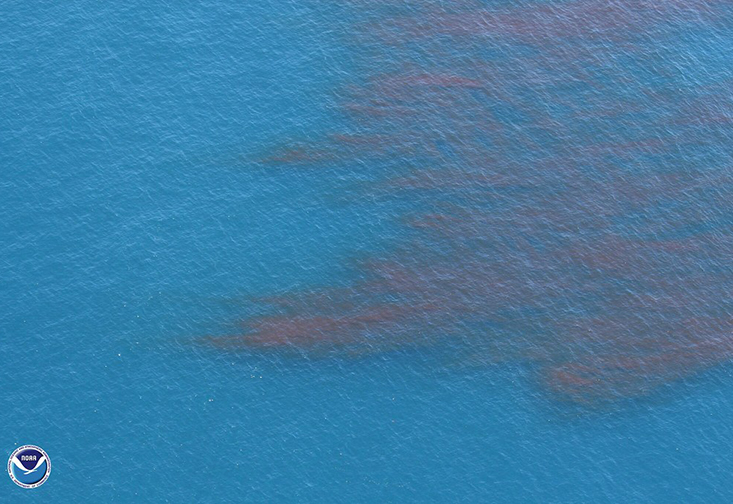On a Monday morning in early January, sophomore Camden Conte carried sampling gear to Bayboro Harbor near the USF College of Marine Science and chucked it into the water. It was Conte’s first day collecting samples for an algal bloom monitoring program for the Fish and Wildlife Research Institute (FWRI). Standing on the seawall, he began to reel in the sampling device, a modified PVC pipe designed to trap water inside, when a dolphin suddenly surfaced and nearly carried the equipment into the bay.
Not every sampling day was so eventful, Conte admits, but the unexpected encounter kickstarted what would become a refreshing way to begin his weeks.
“Most people’s Mondays are not that fun,” he said. “But it was nice to wake up and be out in nature taking samples first thing in the morning.”
Algal blooms are a common occurrence in Florida, appearing along coastlines and in freshwater reservoirs like Lake Okeechobee. Over the past few years, red tide blooms have killed countless wildlife, cleared popular beaches and motivated Governor Ron DeSantis to establish the Florida Red Tide Mitigation and Technology Development Initiative, a partnership between the FWRI and Mote Marine Laboratory, which will receive $3 million annually until 2025 to research the phenomenon.
Since last fall, Conte and sophomore biology major Lydia Ruggles have interned with FWRI’s Harmful Algal Bloom (HAB) Group, a research group at the Florida Fish and Wildlife Conservation Commission. The internship has given the students hands-on experience working with professional scientists and the opportunity to participate in activities within two teams: one in the light microscopy lab, which monitors for red tide and other HABs, and a team working on Pyrodinium bahamense, which does experimental work in the field and in the laboratory.
“Pyrodinium is a type of harmful algae that releases toxins, which can affect marine species,” Ruggles said. “That’s why we’re studying them.”
Born and raised in Indiana, Ruggles has been visiting Florida with her family since she was a child. In high school, she discovered an affinity for math and science – especially marine biology – and decided to pursue her passion at the USF St. Petersburg campus.
During the internship, Ruggles and Conte learned foundational lab techniques that allowed them to contribute to an HAB research group that studies things like the Pyrodinium life cycle and swimming behavior to better understand the threats it poses to humans and wildlife. The students learned to use microscopes to examine water samples taken at different depths. They snapped photos of the samples using camera software, uploaded those photos to a computer and measured the length, width and diameter of the individual cells.
“That tells us what size they are at different water levels and what happens at the different stages of their life cycle,” Ruggles said.
It’s sometimes said that the most important work is also the least glamorous, and that tends to hold true in science. The students were often tasked with maintenance and cleaning, from receiving and preparing samples to sterilizing glass instruments using a large machine called an autoclave. It’s tedious but essential work.
Their most valuable contribution during the internship may have been towards informing the public. Many beachgoers rely on the FWRI website to check on red tide levels before heading to the beach. For months, Conte and Ruggles were directly involved in keeping the public informed by inputting red tide data collected from various locations along the coast.
“The microscopy lab has a huge monitoring database,” said Conte. “Every day, we’d help set up live water samples that came in from across Florida. We’d fix the sample so that it can be analyzed with microscopes, organize samples that needed to be archived and enter data. At the end of the day, the website updates so that people can see the most current results for the sites monitored for red tide across Florida.”
Although access to the labs are currently restricted to staff only due to the coronavirus lockdown, Ruggles and Conte still have an opportunity to engage with FWRI scientists during weekly remote meetings.
Sugandha Shankar, a research scientist who studies Pyrodinium in the HAB Group, said working with the students has been a delight. “It has given us an opportunity to stay on track with our deadlines,” she said. “They have been quick to learn. Both take notes and are communicative.”
Celia Villac, an FWC research scientist who helped oversee the internship, agreed. “I learned to really trust the work they do,” she said. “They were able to trace their own steps and mistakes, which is an important trait in young scientists. They came to us very well prepared, so I think the university is doing a good job.”
Villac added that the partnership between FWRI and USF St. Petersburg has proven to be beneficial. “We are grateful that this bridge has been built and glad we can provide Camden, Lydia and other students this learning opportunity,” she said. “They have been really valuable to us. It’s a two-way street.”
